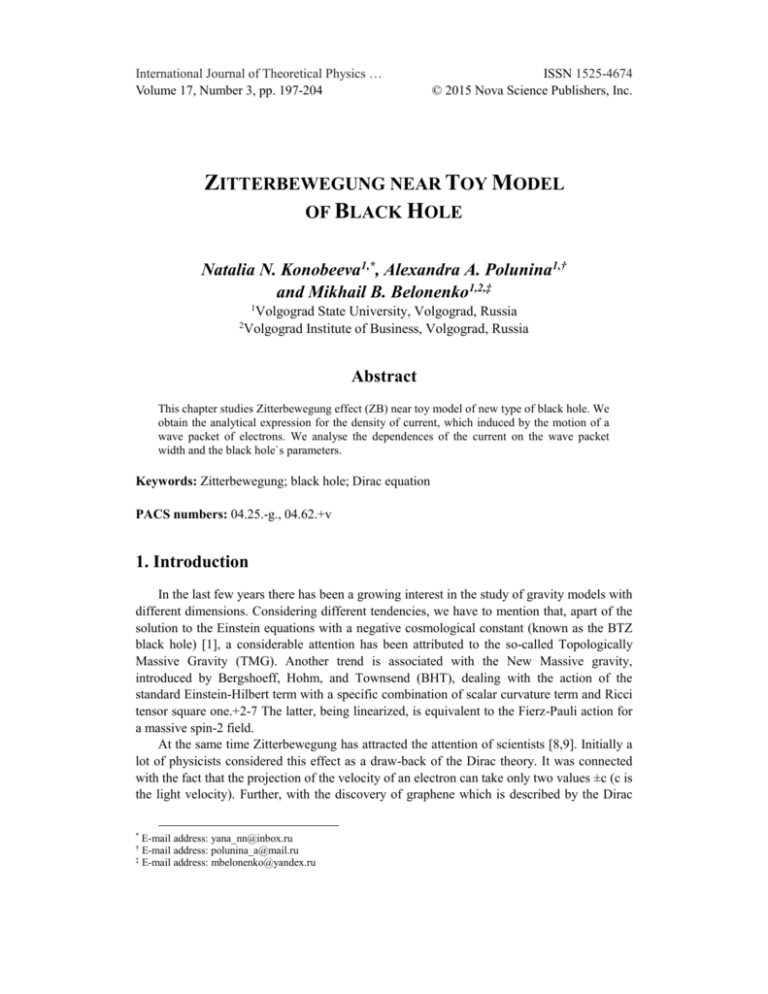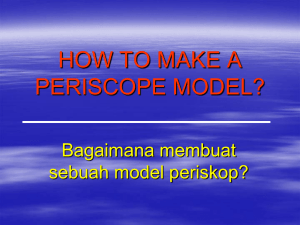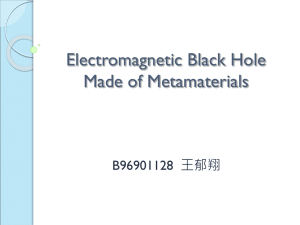Zitterbewegung near Toy Model of Black Hole
advertisement

International Journal of Theoretical Physics … Volume 17, Number 3, pp. 197-204 ISSN 1525-4674 © 2015 Nova Science Publishers, Inc. ZITTERBEWEGUNG NEAR TOY MODEL OF BLACK HOLE Natalia N. Konobeeva1,*, Alexandra A. Polunina1,† and Mikhail B. Belonenko1,2,‡ 1 2 Volgograd State University, Volgograd, Russia Volgograd Institute of Business, Volgograd, Russia Abstract This chapter studies Zitterbewegung effect (ZB) near toy model of new type of black hole. We obtain the analytical expression for the density of current, which induced by the motion of a wave packet of electrons. We analyse the dependences of the current on the wave packet width and the black hole`s parameters. Keywords: Zitterbewegung; black hole; Dirac equation PACS numbers: 04.25.-g., 04.62.+v 1. Introduction In the last few years there has been a growing interest in the study of gravity models with different dimensions. Considering different tendencies, we have to mention that, apart of the solution to the Einstein equations with a negative cosmological constant (known as the BTZ black hole) [1], a considerable attention has been attributed to the so-called Topologically Massive Gravity (TMG). Another trend is associated with the New Massive gravity, introduced by Bergshoeff, Hohm, and Townsend (BHT), dealing with the action of the standard Einstein-Hilbert term with a specific combination of scalar curvature term and Ricci tensor square one.+2-7 The latter, being linearized, is equivalent to the Fierz-Pauli action for a massive spin-2 field. At the same time Zitterbewegung has attracted the attention of scientists [8,9]. Initially a lot of physicists considered this effect as a draw-back of the Dirac theory. It was connected with the fact that the projection of the velocity of an electron can take only two values ±c (с is the light velocity). Further, with the discovery of graphene which is described by the Dirac * E-mail address: yana_nn@inbox.ru E-mail address: polunina_a@mail.ru ‡ E-mail address: mbelonenko@yandex.ru † 198 Natalia N. Konobeeva, Alexandra A. Polunina and Mikhail B. Belonenko equation in the long-wave approximation, the possibility of observing ZB leads to practical applications [10]. Now, we have a point of view that Zitterbewegung effect exists in any system if the Hamiltonian does not commute with the velocity operator [11]. This paper presents the theory of ZB in the curved surface, for example new type of black holes. We propose to use the Shrödinger representation, which allows us to consider the “trembling motion” in the case of the curved space. Thus, purpose of the paper is show the possibility of applying the Shrödinger picture for describing ZB effect near black hole. This approach can be useful for the solving of the problems of the electron radiation near the black holes and other astrophysical problems. It should be noted that since the estimates of the mass black hole is very real costs (from 6.9 Msun to 8∙106Msun) [12] therefore a quantitative analysis is rather difficult. We can say that expected influence of curved space on ZB has a qualitative nature, which manifests itself in additional radiation from the fermions in the field of the black hole, which has not been previously considered. This approach may also be applied to the problem of neutrino oscillations near massive objects. 2. Basic Equations Metric for the black hole when cosmological constant λ has the following form: ds 2 f r dt 2 dr 2 r 2 d 2 . f r (1) where f(r)=Ar2+Br+C. The parameter А is proportional to λ and is determined form the solution of Einstein`s equations Rij-0.5R/gij=λ∙gij (with metric (1)), Rij is the Ricci tensor, R is the scalar curvature, B is a kind of "gravitational hair", the constant C is associated with the mass of the black hole. It should be noted, depending of the values of the parameters А, В, С metric (1) may describes a black hole or not. The roots of f(r) can be written as: r 1 B 2A B 2 4 AC . (2) In the case when r+>0 the metric represents a new type of black holes with an event horizon near r+. Further we consider the case of massless fermionic perturbations (m=0) for asymptotically de Sitter black holes (A<0). Properties of fermions near the black hole will be described on the basis of the Dirac equation generalized for the case of a curved space-time [13]: ( ) 0 . (3) 199 Zitterbewegung near Toy Model of Black Hole Here and below the repeated indices assume summation; ∂μ is the partial derivative with respect to coordinate μ, Ωμ is the component of the spin connection, is the wave function (column vector). As is known [13], if we are given the metric tensor ds 2 g dx dx g g , (4) ( -delta Kronecker symbol) then we can define the field frames (tetrads): g ea eb ab g ea eb ab , ab bc (5) c a Then: 1 b a b ea g ( eb e ) 4 1 g ( g , g , g , ) 2 ea a Note that all the Christoffel symbols are equal to zero for metric (1), except: 001 f ff 1 f 1 2 , 100 , 11 , 12 , 122 fr . 2f 2 2f r And spin connection: 0 0 1 4 f , 1 0, 2 1 2 2 f . From the Dirac equation we have that Hamiltonian is described by Eq. (6): 0 Hˆ if r r if if f 0 4 2r 2 0 1 f 0 2 1 0 r The Heisenberg equations can be written as [12]: . 0 (6) 200 Natalia N. Konobeeva, Alexandra A. Polunina and Mikhail B. Belonenko rˆ i[ Hˆ , rˆ ] . (7) А standard approach of ZB (namely to Heisenberg picture) gives us some problem. It's easy to see that solving of the ZB problem in a curved space-time is rather difficult. This is due to the non closed system of operator equations follow from Eq. (7) in the curved space. So, we apply the Shrödinger picture: rˆ rˆ 0 , (t) . The current can be calculated as: j (t) v (t) (t) r (t) , here v is the electron`s velocity. Because i H representation: and we have in the eigenvalues (t) C ei t (t) , 0 we can obtain: j i (t) r , H (t) . Next we suppose there is a solution: (r) (8) 1 (r) 2 (r) Using the change of variables: y=1-r+/r- [14]. We obtain the Dirac equation in the following form: y y 1 Q 1 y 0.5 2 y 1 Q 1 y . k 2Q 2Q 2 iQ 1 1 2 2 1 y 0 Ar Ar y y 1 Q 2 Ar y 1 Q y (9) Here we have defined Q=r+/r-, where r- corresponds to the cosmological horizon (r-> r+). Performing the changes of variables according the work of P.A. Gonzalez and Y. Vasquez [15]. 1 y y y 1 Q F y . The equation (6) is reduced to 201 Zitterbewegung near Toy Model of Black Hole y y 1 Q F y 0.5 Q 11 4 2 y 1 2 2 F y k 2Q 2 2 F y 0 r iQ Ar 1 Q . (10) Then, making the changes of variables: (1-Q)z=y, we obtain the hypergeometric equation: z 1 z F z c z 1 a b F z abF z 0 a ik Q ,b A r ik Q , c 0.5 2 . (11) A r The general solution of Eq. (11) is: F z С1 2 F1 a, b, c; z С2 z1c 2 F1 a c 1, b c 1, 2 c; z , (12) where 2F1(a,b,c;z) is a hypergeometric function, С1, С2 are constants. Thus, the solution for the radial function can be written as: 1 z С1 z 1 z 2 F1 a, b, c; z С2 z1/ 22 2 F1 a c 1, b c 1, 2 c; z . (13) The wave function is: z (r , ) 1 . 2 z (r , t) d e 0 2 (14) ( ) / 2 1 it 1 it . ( ) C1 e C2 e 2 2 (15) We choose wave packet in a Gaussian form in the energy representation. It does not matter because the developed method uses a specific form of the packet. In our case the commutator is: 0 r r r r rˆ , Hˆ i . 0 r r r r 202 Natalia N. Konobeeva, Alexandra A. Polunina and Mikhail B. Belonenko The result for the current is given by: j(r , t) d e C1 C * 2 * 1 0 / 2 2 2cos t f r C1*C2 1* 2 C1*C2 1 2* . 2 C1 C 1 * 2 (16) * 2 3. Results Evolution of the average of the current operator for the different values r is shown in Fig. 1. Figure 1. Dependence of the current density (in relativity units) on time (A=-1, B=-3, C=4, Δ=0.5): a) r=2; b) r=5; c) r=10. Figure 2. Dependence of the current density (in relativity units) on time (A=-1, B=-3, C=4, r=2): a) Δ=0.1; b) Δ=0.7. Zitterbewegung near Toy Model of Black Hole 203 From this dependence, it can be concluded that we can observe ZB-effect near black hole. The influence of the parameter r is obvious. At the r=10 we can observe the greatest “trembling motion”, i.e. when r increases. It is easy to explain, if we take into account that r corresponds to the radial distribution of the electrons density and with increasing of parameter r the electron density is distributed more delocalized. An influence of the packet width on the current density can be found in Fig. 2. Note that the “damping” value of the trembling motion is directly related with the packet width and there is an agreement with all the results on the ZB-effect. There isn't damping if the packet have a "zero" width, the trembling motion continues indefinitely and “damping” is absent. An influence of parameter Q (Q=r+/r-)on the density of current is presented in Fig. 3. Figure 3. Dependence of the current density (in relativity units) on time (r=2, Δ=0.5): a) Q=-4 (A=-1, B=-3, C=4); b) Q=-6 (A=-1, B=-5, C=6); c) Q=-9 (A=-1, B=-8, C=9). As can be seen from Fig.3, ZB effect decreases when the value of |Q| decreases too.ь Note, the parameter Q is calculated directly through the constants in the metric tensor and is associated with space-time geometry. It can be concluded that the effect ZB depends on the geometry of the space-time. Based on the results it can be concluded that the proposed approach is based on the Shrödinger representation for evolution, allows us to consider the “trembling motion” in the case of the curved space. The above example demonstrates the possibility of applying this approach to astrophysical problems, in particular to problems of the electron radiation near the black holes. More precisely, we can say that in our case the result can be applied to the problem of neutrino oscillations near massive objects in the anti-de Sitter universe. Thus, this effect can be a reason of extra electron radiation near the black holes and of a change in the emitted spectrum of the electromagnetic waves. This research is not aimed at a detailed examination of such influence and to find possible evidence in its favor. But from general considerations it can be assumed this effect may amend the discussed spectra. Also, it should be noted that given consideration of the ZB effect can be readily used in the investigation of the neutrino dynamics in the field of the black holes. 204 Natalia N. Konobeeva, Alexandra A. Polunina and Mikhail B. Belonenko The most controversial is the question of a real application of the metric of the form (1) to astrophysical objects. It should be noted that the essence of the method developed by us is to use the Schrödinger representation for consideration ZB effect and only requires knowledge of the system of eigenfunctions of the corresponding Dirac equation. We choose this model because of the fact that the corresponding system functions are known in analytic form. Obviously, to talk about the real-world applications we should to consider the Schwarzschild black hole, which existence has the evidence. In this case, there are some difficulties with the analytical expression of the corresponding system functions, but there is no fundamental limitations on the proposed method. Acknowledgments The authors are grateful to Dr. Shura Hayryan (Academia Sinica) for the inspiration and valuable discussions. References [1] [2] [3] [4] [5] [6] [7] [8] [9] [10] [11] [12] [13] [14] [15] Banados, M., Teitelboim, C., Zanelli, J. Phys. Rev. Lett. 1992, 69, 1849-1851. Bergshoeff, E. A., Hohm, O., Townsend, P. K. Phys. Rev. Lett. 2009, 102, 201301. Bergshoeff, E. A., Hohm, O., Townsend, P. K. Phys. Rev. D. 2009, 79, 124042. Bergshoeff, E. A., Hohm, O., Townsend, P. K. Annals Phys. 2010, 325, 1118-1134. Bergshoeff, E. A., Hohm, O., Townsend, P. K. J. Phys. Conf. Ser. 2010, 229, 012005. Andringa, R., Bergshoeff, E. A., de Roo, M., Hohm, O., Sezgin, E., Townsend, P. K. Class. Quant. Grav. 2010, 27, 025010. Bergshoeff, E. A., Hohm, O., Rosseel, J., Sezgin, E., Townsend, P. K. Class. Quant. Grav. 2011, 28, 015002. Zawadzki, W. Optical properties of solids; Gordon and Breach: New York, US, 1970, p. 179. Zawadzki, W. High magnetic fields in the physics of semiconductors II; World scientific: Singapore, SG, 1997, p. 755. Konobeeva, N. N., Belonenko, M. B. Phys.B: Cond. Matt. 2014, 456, 115-117. Zawadzki, W., Rusin, T. Phys. Let. A. 2010, 374, 3533. Gelino, D. M., Balman, S., Kiziloglu, U., Yilmaz, A., Kalemci, E., Tomsick, J. A. ApJ. 2006, 642, 438-442. Birrell, N. D., Davis, P. C. W. Quantum Fields in Curved Space. University Press: Cambridge, 1982. Landau, L. D., Lifshitz, E. М. Quantum mechanics (non-relativistic theory); Fizmatlit: Moscow, RU, 2001, p.315. Gonzalez, P.A., Vasquez, Y. (2014). Dirac Quasinormal Modes of New Type of Black Holes [http://arxiv.org/abs/1404.5371]. MA






